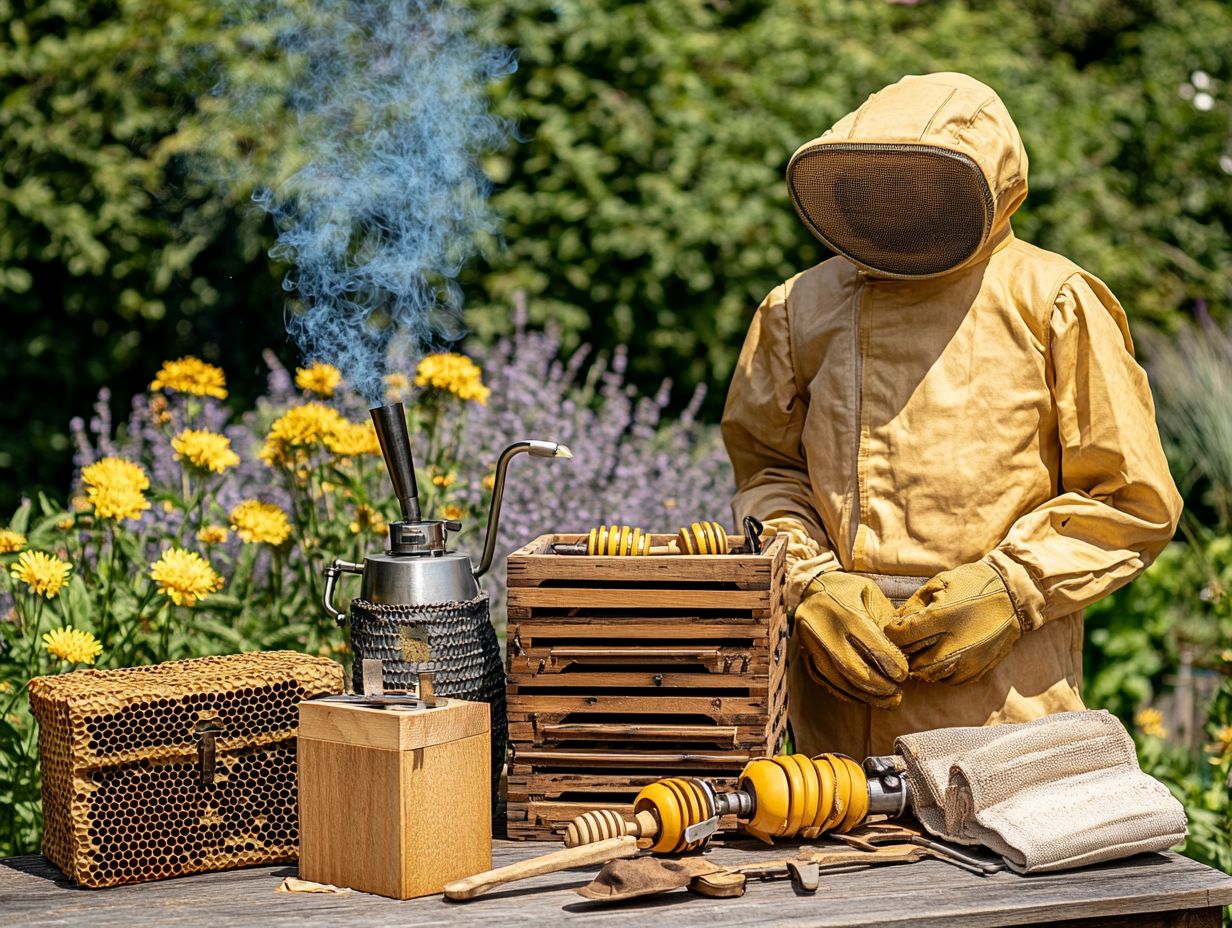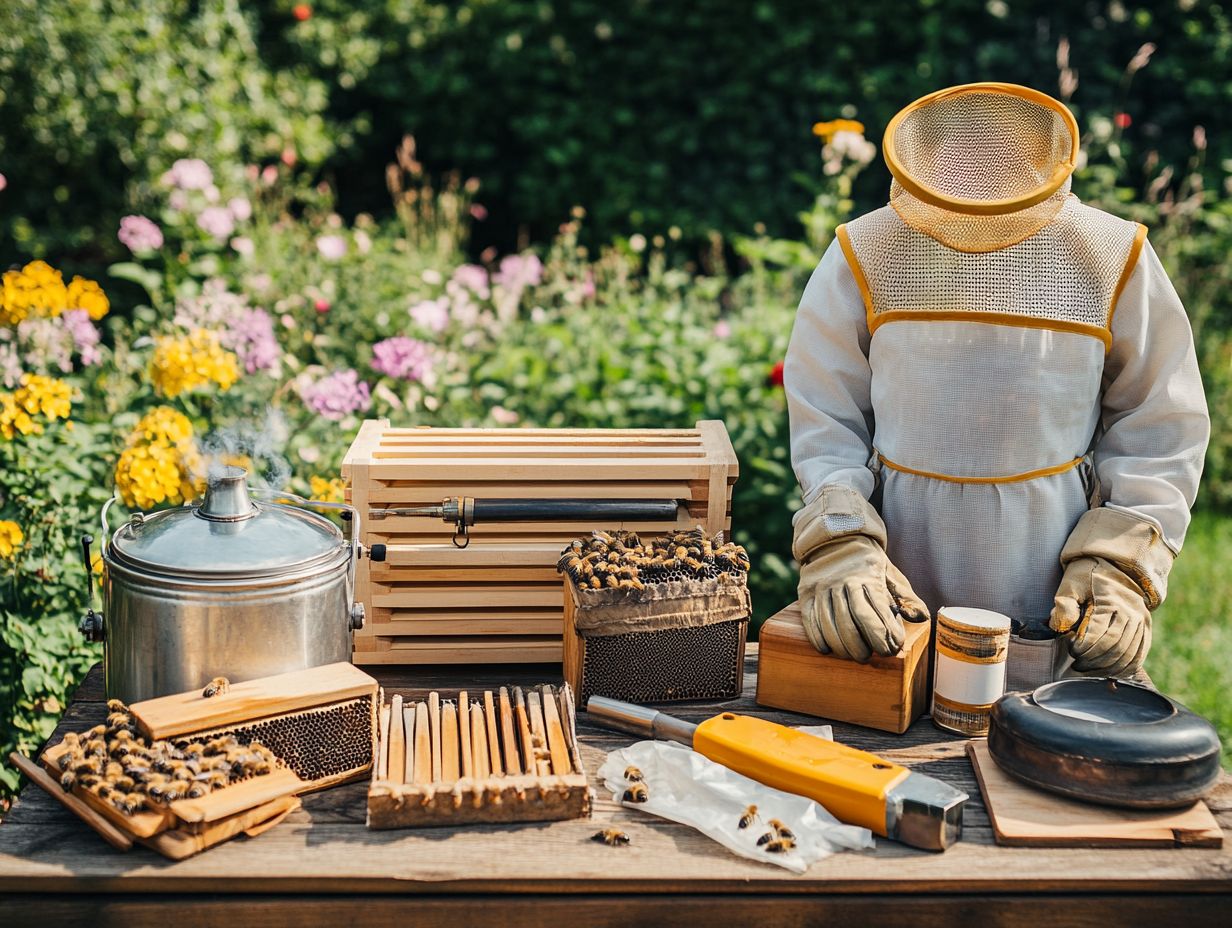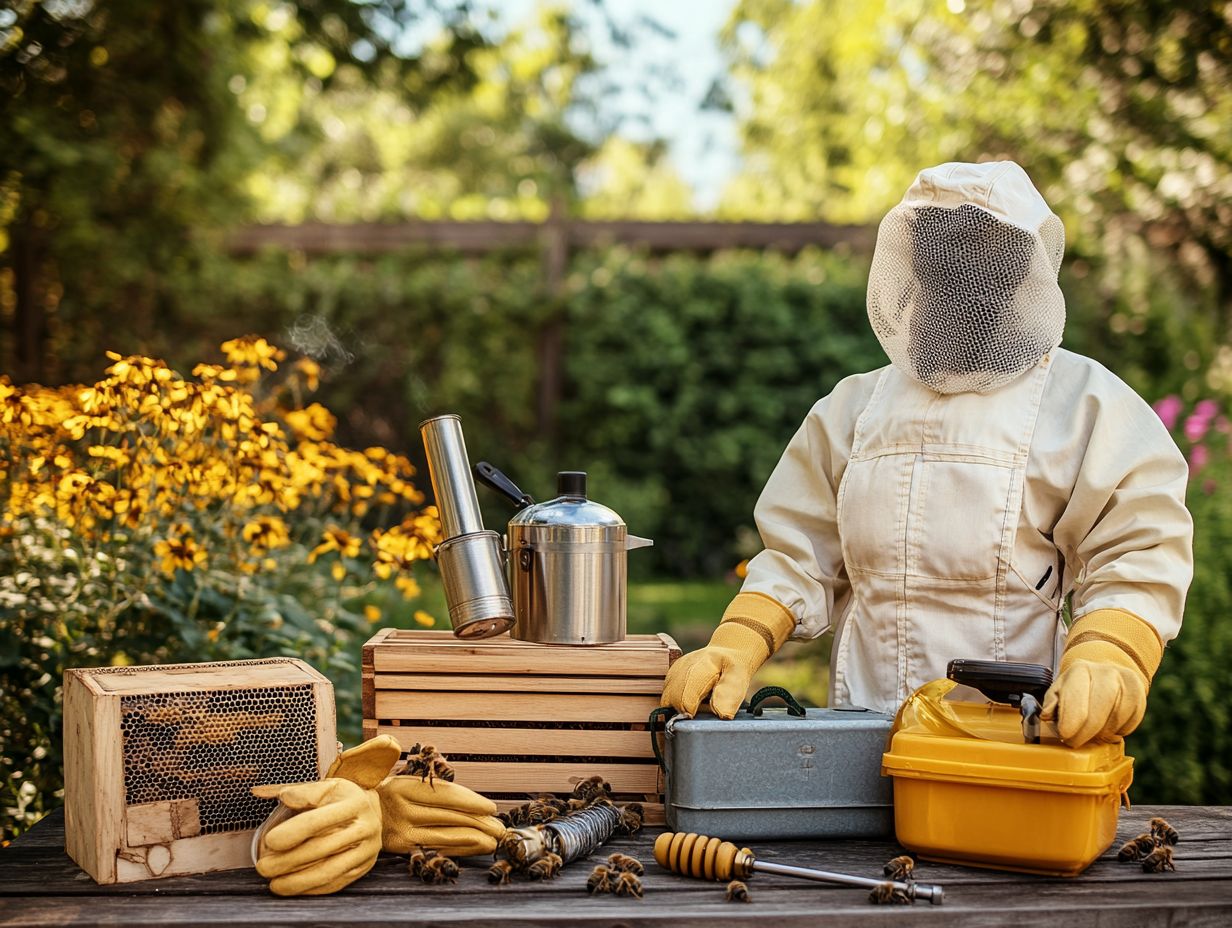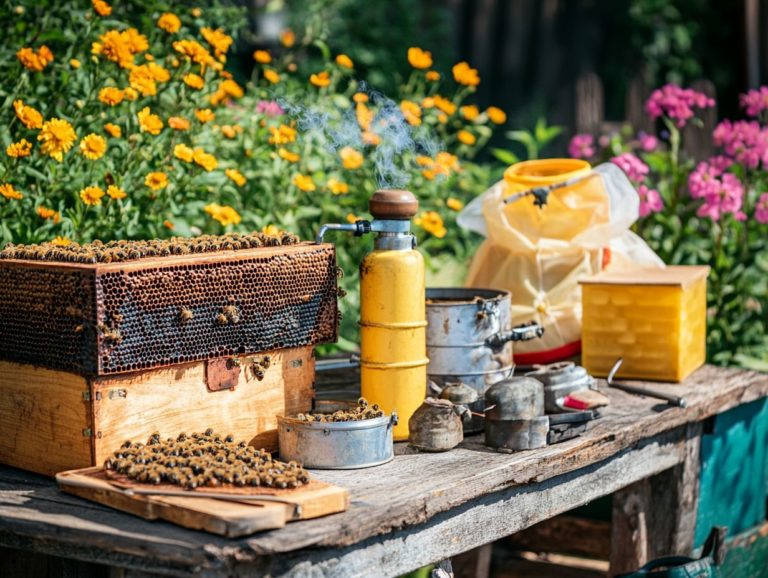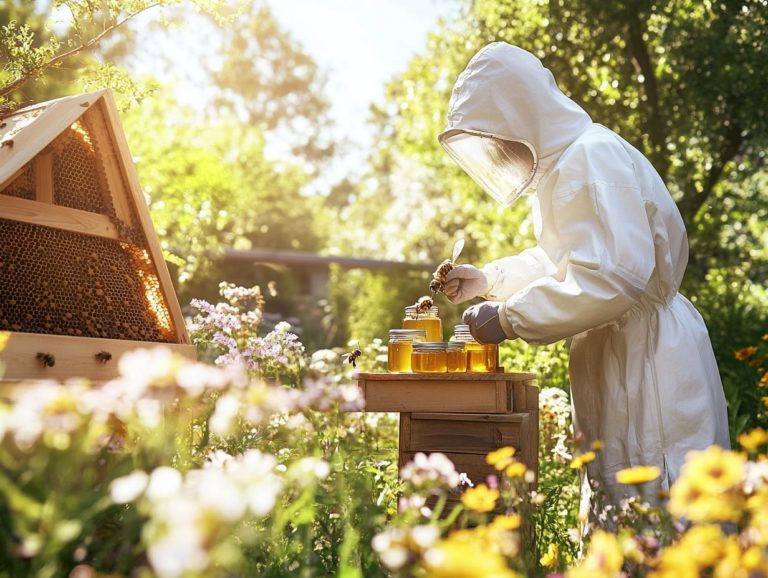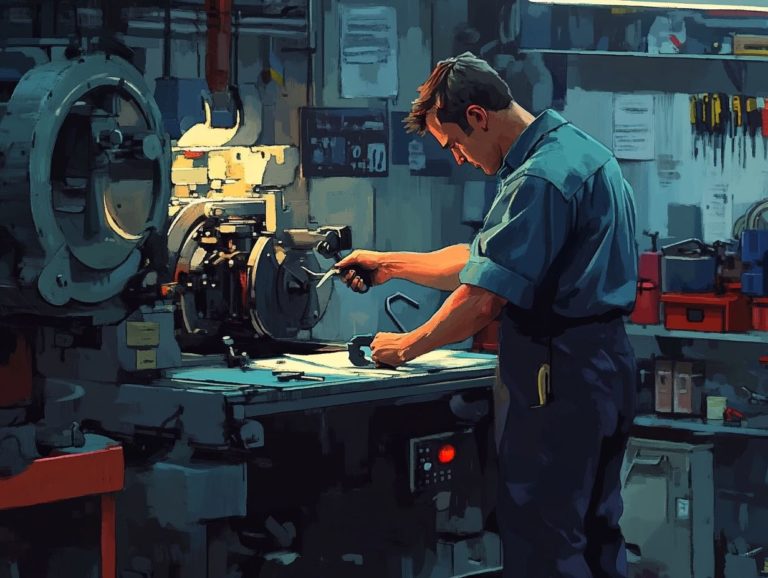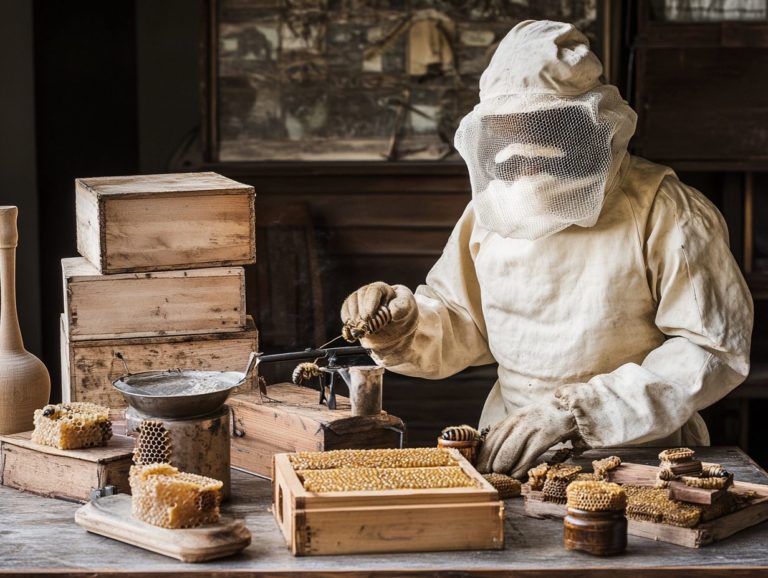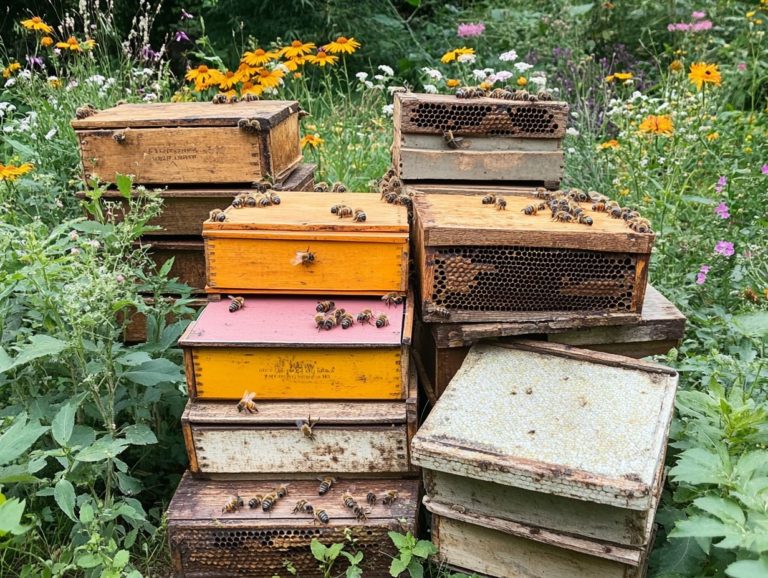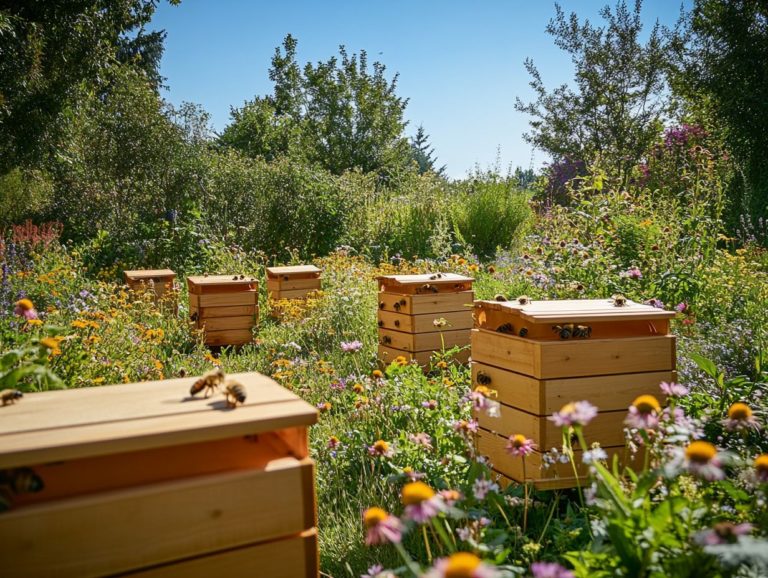Beginners Guide to Beekeeping Equipment
Beekeeping is a blend of artistry and scientific precision. Having the right tools is crucial for nurturing a flourishing hive and ensuring successful honey production.
Investing in quality beekeeping supplies can further enhance your experience. Understanding the significance of quality beekeeping equipment is vital, whether you’re just starting out or have years of experience under your belt.
Must-have beekeeping tools can make all the difference. This guide will walk you through the essential tools you need, from necessary items like beehives and smokers to optional tools that can elevate your beekeeping experience, such as a honey extractor or a bee brush.
It also provides insights on where to purchase your equipment, tips for maintenance, and essential safety precautions. Immerse yourself in this knowledge to discover how the right gear can streamline your beekeeping journey and make it all the more rewarding, ensuring a healthy hive.
Contents
- Key Takeaways:
- Why Is Beekeeping Equipment Important?
- What Are The Essential Tools For Beekeeping?
- What Are The Optional Tools For Beekeeping?
- Where Can You Purchase Beekeeping Equipment?
- How To Properly Clean And Maintain Beekeeping Equipment?
- What Are The Safety Precautions When Using Beekeeping Equipment?
- Frequently Asked Questions
Key Takeaways:
- Choose quality tools to boost your success in beekeeping.
- Essential tools for beekeeping include a beehive, smoker, and protective clothing, such as bee suits, for your safety.
- Optional tools like pollen traps, honey refractometers, and queen catchers can enhance your experience but are not necessary for beginners.
Why Is Beekeeping Equipment Important?
Beekeeping equipment is essential for maintaining and enhancing the productivity of honeybees. The right supplies not only facilitate thorough hive inspections but also promote the overall health of the colony.
This results in vigorous and thriving populations. Experts in the field, such as Adam Martin, highlight the significance of utilizing appropriate tools and equipment.
Utilizing the right gear helps achieve the best outcomes in honey production and bee care. Without the correct tools, beekeepers may face challenges in fostering a flourishing environment for their bees.
This can ultimately impact both honey yield and quality.
What Are The Different Types Of Beekeeping Equipment?
Understanding the various types of beekeeping equipment is essential for you as an aspiring beekeeper. This knowledge helps you develop effective methods for managing your hives.
You’ll encounter common equipment like Langstroth frames, which are crucial for hive management. You’ll also have options to choose between vertical and horizontal hives that cater to different beekeeping styles.
Each type has its unique purpose and can significantly impact the health of your hive and the productivity of your honeybees. For example, Langstroth frames allow easy access for inspections and honey harvesting, which is vital for monitoring colony health.
Vertical hives, with their multiple supers, maximize honey storage while providing ample room for hive expansion. This ensures a productive environment. On the other hand, horizontal hives promote more natural bee behavior and can be less disruptive during inspections.
By selecting the right equipment, you can better support your bees. This ensures a thriving community that contributes positively to local ecosystems.
What Are The Essential Tools For Beekeeping?
Let’s explore the must-have tools every beekeeper should know. In the world of beekeeping, certain tools rise to the top as critical supplies, each playing a vital role in nurturing a healthy and productive hive.
For instance, the hive tool is essential for accessing hives and inspecting frames. This ensures that you can manage your bees with ease.
A hive smoker is invaluable for soothing the bees during inspections, enhancing safety and efficiency throughout the process. A honey extractor lets you extract honey without damaging the comb.
A gentle bee brush helps you remove bees from frames delicately, ensuring their safety.
1. Beehive
The beehive serves as the heart of beekeeping, acting as a sanctuary for honey bees and a hub for honeycomb production. Its intricate design is masterfully crafted to facilitate ventilation, insulation, and ample space for bees to flourish, creating ideal conditions for nurturing brood and storing that sweet honey.
Among the various hive options, the Langstroth hive shines not only for its ease of management but also for its ingenious design that allows you to inspect frames without disturbing the entire colony. This modular setup makes honey harvesting efficient while prioritizing the well-being of the hive’s inhabitants.
The honeycomb, a vital element of the beehive, plays a critical role in honey production, offering a secure environment for bees to store nectar and pollen, ensuring the overall health and sustainability of the hive.
2. Smoker
A hive smoker is an essential tool for you as a beekeeper, expertly crafted to produce smoke that soothes honey bees during your hive inspections. This calming effect allows you to work more safely and efficiently, significantly reducing the chances of bee aggression while managing your hive. Mastering the smoker is essential for a smooth inspection.
When you fill the smoker with the right materials—think burlap or dry leaves—it generates cool smoke that effectively masks the alarm pheromones (chemicals bees release to signal danger) released by the bees. This is crucial for successful inspections, as it allows you to assess the hive’s condition without provoking defensive behavior from your bees.
To get the best results, light your smoker well ahead of time and gently puff the smoke into the entrance and seams of the hive, ensuring minimal disturbance. By incorporating these best practices, you cultivate a healthier environment for your colonies, ultimately leading to stronger hives and more fruitful yields.
3. Hive Tool
The hive tool is a critical piece of equipment that every beekeeper should possess, serving a crucial role in frame management and hive maintenance. This versatile tool helps you pry apart hive components for easier inspection, making it easier to look for signs of disease, pests, or cells that indicate a colony is preparing to swarm. A reliable hive tool enhances the efficiency of your inspections, allowing you to swiftly assess the health of your colonies.
Choosing the right hive tool is key to your beekeeping success! Factors to consider include material durability and ergonomic design for a comfortable grip. Popular choices among beekeepers are stainless steel or wood options, valued for their longevity and user-friendliness. Some models even come with integrated scraping edges, perfect for unclogging wax and propolis (a sticky substance bees use to seal gaps in the hive) that can block access to the frames.
By investing in a high-quality hive tool, you can streamline your maintenance tasks, ultimately fostering healthier hives and boosting your honey yields.
4. Bee Brush
A bee brush is your trusted companion in the world of beekeeping—a specialized tool designed for the gentle handling of bees during inspections. With this tool in hand, you can gently remove bees from frames. This ensures a stress-free environment for the hive. It’s a vital addition to your beekeeping toolkit, ensuring the safety of both you and your buzzing friends. Mastering the use of a bee brush can elevate your hive inspections, allowing for more accurate assessments of colony health.
When you employ best practices with your bee brush, such as stroking bees towards the end of the frame and being attuned to their movements, you minimize stress and agitation within the hive. This gentle approach creates a calm environment, essential for hive productivity and overall well-being.
Conducting routine inspections with the proper use of a bee brush significantly aids in the early detection of issues like pests or diseases, ultimately nurturing a healthier and more resilient colony. When you adopt this practice, you protect the bees and build a fantastic bond with your hive!
5. Protective Clothing
Wearing the right protective clothing, like bee suits, is essential for your safety when working with honey bees. These suits are carefully made to shield you from potential stings, allowing you to concentrate on inspecting hives and managing your colonies without the fear of being stung.
In beekeeping classes, you’ll often hear about the importance of proper safety gear, which creates a secure environment for both you and the bees.
However, there’s more to protective gear than just standard bee suits. You can also find various options available, like gloves and jackets for added protection. Each item, including veils, gloves, and jackets, is specifically designed to meet your unique needs.
Veils, for instance, offer excellent face protection while ensuring you can see what you’re doing, minimizing the risk of stings to sensitive areas, especially during hive inspections. Gloves, whether made from leather or synthetic materials, provide that added layer of hand protection, allowing you to choose based on your comfort and dexterity.
These protective items not only enhance your safety but also help preserve the hive’s overall health by reducing disturbances that might arise from unexpected reactions, ensuring a thriving environment.
Understanding the diverse range of protective gear, as emphasized in many beekeeping classes, reinforces the critical nature of safety in your beekeeping journey. This knowledge helps you build confidence and competence, whether you’re a novice or a seasoned beekeeper.
6. Queen Excluder
A Queen excluder (a device that keeps the queen bee from laying eggs in honey storage areas) is an essential tool in your hive management arsenal. It is expertly designed to keep the queen bee separated from honey supers while allowing those diligent worker bees to move freely. This smart tool keeps your honey pure and delicious, free from baby bees, ultimately enhancing the quality of the honey you harvest.
By preventing the queen from laying eggs in your honey storage area, this device plays a vital role in maintaining honey purity. It ensures that your final product is not only delicious but also free of any unwanted impurities.
Using a Queen excluder effectively is crucial for beekeepers like you who aim to optimize harvests. It streamlines the honey extraction process, making it not just more efficient but also more appealing to potential customers. This tool helps regulate hive dynamics, allowing you to monitor and manage the health and productivity of your colonies without compromising honey quality.
7. Feeder
A feeder is essential for providing supplemental nutrition to honey bees, especially when natural foraging opportunities are scarce. As a beekeeper, you can use feeders to supply sugar syrup, helping your colonies build strength, particularly during early spring or dearth periods.
Understanding the various types and methods of hive feeding is crucial for maintaining a healthy hive and supporting robust colonies.
You’ll find that there are different types of feeders tailored to meet specific needs and preferences. For instance, entrance feeders are compact and allow easy access for the bees, while frame feeders integrate seamlessly into the hive, minimizing disturbance. Each type has its advantages based on the season and the particular needs of your bees.
By regularly monitoring the sugar syrup levels and adjusting your feeding practices accordingly, you can ensure that your hives receive optimal sustenance.
Feeding plays a vital role in colony health, as it promotes brood production, encourages foraging behavior, and enhances the hive’s resistance to diseases—ultimately ensuring a thriving bee population under your care.
8. Honey Extractor
The honey extractor is a critical tool for you as a beekeeper, allowing for efficient honey harvesting while preserving the integrity of the comb and hive structure.
By using a spinning motion, it helps extract honey from the frames. It ensures that the comb remains intact for future use.
Investing in a high-quality honey extractor can significantly elevate both the yield and quality of honey during the harvesting season.
You’ll find a variety of honey extractors available, from manual to electric versions, each tailored to meet the unique needs of beekeepers at different scales.
Manual extractors are perfect for hobbyists tending to a few hives, while electric extractors are designed to accommodate larger operations with multiple colonies.
Regardless of which type you choose, all extractors streamline the harvesting process, enabling you to manage combs efficiently without compromising the health of your hive.
This method saves you time and makes harvesting honey easier, transforming honey harvesting into a more enjoyable and rewarding experience.
Ultimately, using an extractor is essential for anyone committed to maintaining sustainable practices in apiculture.
9. Uncapping Knife
An uncapping knife is a critical tool in your honey extraction arsenal, expertly designed to remove wax caps from honeycomb cells before you extract the golden nectar.
This step is crucial for ensuring that honey flows freely from the comb during extraction, helping you collect honey more easily.
By investing in a high-quality uncapping knife, you can streamline your honey harvesting process and significantly boost your overall productivity.
You’ll find a variety of uncapping knives tailored to meet diverse beekeeping needs.
For instance, electric uncapping knives utilize heated blades to swiftly melt away wax caps, dramatically accelerating the extraction process.
On the other hand, manual uncapping knives offer a traditional touch, giving you greater control and precision.
Some even come with serrated edges, making it a breeze to slice through stubborn cappings.
No matter which type you choose, using an effective uncapping knife enhances your honeycomb management.
It also plays a critical role in maintaining the integrity of your hive, ensuring a plentiful harvest time and time again.
What Are The Optional Tools For Beekeeping?
While essential tools are vital for effective beekeeping, there are several optional tools that can elevate your experience and enhance the efficiency of managing your hive.
Though these tools aren’t mandatory, they can significantly improve both honey harvesting and the overall health of your colony.
By familiarizing yourself with these various beekeeping supplies, you can build a comprehensive toolkit tailored to a variety of situations.
This ensures you’re always prepared for whatever comes your way.
1. Pollen Trap
A pollen trap is an optional yet highly beneficial tool for you as a beekeeper, specifically designed to collect pollen from the bees as they enter the hive.
This practice boosts pollination and helps create a healthy hive. It provides essential nutrients for your colony.
If you want to produce pollen for human consumption or other uses, this tool is a must-have!
By strategically using the trap, you can streamline the collection process without disrupting the bees’ natural foraging habits.
As bees make their way into the hive, they inadvertently shed pollen, which the trap captures.
This enables you to monitor and manage the nutritional needs of your colonies more effectively.
This practice not only bolsters the overall health of your hive but also underscores the vital role of pollen in strengthening bee nutrition.
Incorporating a pollen-rich diet can lead to improved hive productivity, ultimately benefiting the broader ecosystem through enhanced pollination activities.
2. Queen Catcher
A Queen catcher is an invaluable tool for you as a beekeeper, specifically designed to safely capture and manage the queen bee during your hive management tasks. This tool minimizes stress for the queen, allowing you to perform better inspections and health assessments of the hive. Mastering the effective use of a Queen catcher will greatly improve your efficiency and success in beekeeping.
You’ll find various types of Queen catchers available, each boasting unique features tailored to different handling situations. For example, a small, mesh Queen catcher provides visibility while keeping the queen secure, making it perfect for quick inspections. On the other hand, a sturdier, hard-shell catcher might be your go-to for more involved tasks like colony requeening or hive relocation.
Employing best practices, such as ensuring calm conditions in the hive and adhering to proper handling techniques, will further optimize the effectiveness of these catchers. By integrating these tools into your hive management, you can enhance colony health, leading to thriving populations and improved honey production.
3. Honey Refractometer
A honey refractometer is a critical tool for you as a beekeeper striving for the highest quality and consistency in your honey. By measuring the moisture content—the amount of water in honey—this device enables you to determine whether your honey is ready for harvesting or needs additional drying. Maintaining optimal moisture levels is essential for preserving the integrity of your honey and preventing fermentation.
This handheld instrument delivers precise readings that guide your harvesting process, ensuring you collect honey at its absolute peak. With a refractometer in hand, you can sidestep the common pitfalls that lead to a lackluster product, ultimately preserving the honey’s rich flavor, enticing aroma, and extended shelf life.
By regularly monitoring moisture levels, you can significantly enhance the marketability of your honey, as consumers often seek products with lower water content. This tool is your secret weapon for top-notch honey! It plays a critical role in your success in honey production and sales.
4. Comb Cutter
A comb cutter is an optional yet highly beneficial tool that can significantly enhance your beekeeping experience during honey extraction. It allows for precise cutting of honeycomb sections, leading to more efficient harvesting and minimizing damage to the hive structure. By incorporating a comb cutter into your toolkit, you can elevate the entire extraction process and potentially boost your honey yield.
When you ensure a clean cut, this tool helps maintain the integrity of the remaining comb, fostering healthier bee colonies. Many beekeepers who use a comb cutter discover that it saves valuable time during extraction, allowing for a swift and hassle-free honey harvest.
To make the most of this tool, remember to properly sanitize the cutter before use to prevent introducing dirt or germs into the hive. Using the cutter at the right angle enhances your efficiency, making honeycomb management smoother and more effective overall.
5. Beekeeping Gloves
Beekeeping gloves are essential components of your personal protective equipment, offering an invaluable layer of safety when you’re working with honey bees. These gloves shield you from stings while still allowing the dexterity you need during hive management tasks. Choosing the right pair can significantly enhance your comfort and security throughout the experience.
You’ll find various types of gloves available, each crafted from different materials and levels of thickness to match your unique preferences and working conditions. For example, leather gloves provide durability and outstanding sting protection, while lighter cotton gloves offer increased flexibility and ventilation. Some even come with reinforced fingertips for that extra peace of mind.
Recognizing the importance of these gloves in ensuring both safety and comfort enriches your beekeeping experience and boosts your confidence when tending to hives. Selecting the right gloves tailored to your specific needs is crucial for effective and enjoyable hive management.
Gear up with these essential tools and watch your beekeeping journey thrive!
Where Can You Purchase Beekeeping Equipment?
When you’re ready to dive into beekeeping, purchasing the right equipment can be accomplished through a variety of channels, including local shops and online retailers that specialize in beekeeping supplies. As you search for those essential tools, consider factors like quality, price, and the availability of support or education to help you use the products effectively.
Whether you’re just starting out or you’ve been in the game for a while, choosing reliable sources for your beekeeping needs is vital for maintaining strong colonies.
Local shops often offer the benefit of personalized service and the chance to see equipment up close. This allows you to assess quality and fit before making a purchase. However, keep in mind that prices may be higher due to overhead costs and limited inventory.
On the flip side, online retailers typically present a broader selection at competitive prices. However, they might fall short on immediate support or the opportunity to inspect items in person.
As a beekeeper, consider these factors carefully to ensure your beekeeping journey is a success! The tools you select—like hives, smokers, and protective gear—should align with your specific goals and experience levels.
How To Properly Clean And Maintain Beekeeping Equipment?
Proper cleaning and maintenance of your beekeeping equipment are essential practices that ensure the longevity and functionality of your supplies. Regularly attending to tools like hive smokers, honey extractors, and uncapping knives helps prevent the buildup of harmful germs and bugs that can jeopardize the health of your hives.
Regularly inspecting and maintaining your equipment significantly extends its life, ultimately leading to more successful beekeeping.
By integrating thorough cleaning routines for each tool, you can foster a sanitary environment that mitigates disease transmission among your bee populations. For instance, use sanitizers safe for food handling on honey extractors and ensure uncapping knives are free from any sticky residue to minimize risks.
Store your tools in a dry, protected area to preserve their condition. Addressing these straightforward yet effective practices not only safeguards your bees but also enhances your overall yield. Make hygiene a critical aspect of responsible beekeeping!
What Are The Safety Precautions When Using Beekeeping Equipment?
Safety precautions are absolutely essential for you as a beekeeper when using beekeeping equipment, given that working with honey bees can introduce certain risks if proper care isn’t taken. Implement safety measures—like donning protective clothing, including bee suits and gloves—to minimize the likelihood of stings during your hive inspections.
By understanding the potential hazards linked to various tools and equipment, you can ensure a safer and more enjoyable experience while managing your colonies.
Maintaining your equipment and keeping it free from sharp edges is crucial. Regularly inspecting tools such as smokers and hive tools helps prevent accidents that might stem from malfunctions or wear and tear.
It’s also wise to have a first aid kit specifically designed for bee stings at your disposal, as timely treatment can significantly alleviate discomfort. Familiarizing yourself with bee behavior under different conditions will guide you in selecting the optimal times and methods for handling your colonies. This will further enhance your safety in the apiary.
Frequently Asked Questions
What is the purpose of beekeeping equipment?
The purpose of beekeeping equipment is to assist beekeepers in managing and maintaining their bee colonies. It helps to protect both the bees and the beekeeper, while also providing an environment that allows the bees to produce honey and other products.
What are the essential pieces of beekeeping equipment for beginners?
The essential pieces of beekeeping equipment for beginners include a hive, frames, a smoker, a hive tool, a bee suit, and a veil. These items are necessary for basic hive maintenance and bee handling.
How do I choose the right hive for my beekeeping needs?
Choosing the right hive is crucial for your success. Popular options include Langstroth, Top Bar, and Warre hives. Each has its own benefits, so consider what fits your style and goals best.
Do some research and talk to experienced beekeepers for insights before making a choice.
Do I need to wear a bee suit while beekeeping?
As a beginner, wearing a bee suit is a smart choice. It protects you from stings and lets you focus on enjoying beekeeping.
Experienced beekeepers may choose to leave off the suit, but it’s essential to at least wear a veil and gloves for safety.
How often should I inspect my beekeeping equipment?
Inspect your equipment weekly during peak season. This helps you monitor your bees’ health and catch any issues early.
Can I reuse beekeeping equipment?
Absolutely! You can reuse items like frames and hive boxes. Just remember to clean them well to keep your bees healthy.
Replace gear like gloves and veils regularly for hygiene to keep your bees happy and thriving.


